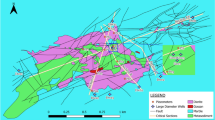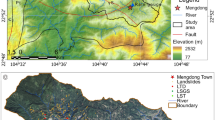Abstract
The Chikkaballapur district has been identified as one of the chronically drought-prone areas. The Rainfall data indicate that out of 11 consecutive years, 8–9 years of the district has faced the drought. The occurrence of drought is on several factors, such as unorganized cropping method, soil types, lack of conservation of water, drainage system, etc. There are no perennial rivers in Chickballapur district. In this study area, a part of the Palar river basin originates at Ambajidurga hillocks in Chintamani taluk and flows in NW–SE direction. The drainage pattern in the study area varies from dendritic to sub-dendritic and is designated as a fifth-order stream. The order of the stream is mainly regulated by the physiography and lithological conditions of the region. The drainage density (0.564 km/km2) and drainage texture values suggest that the study area comprises primarily Precambrian age impermeable rocks. The higher mean bifurcation ratio is indicative of good structural control over drainage growth. Values of the form factor, circulatory ratio, and elongation ratio indicate the sub-watersheds are elongated in shape. These quantitative forecasts can aid in the achievement and implementation of long-term strategies to tackle drought and areas affected to prepare adequate groundwater management plans.








Similar content being viewed by others
References
Abdeta GC, Tesemma AB, Tura AL, Atlabachew GH (2020) Morphometric analysis for prioritizing sub-watersheds and management planning and practices in Gidabo Basin, Southern Rift Valley of Ethiopia. Appl Water Sci 10(7):1–15
Altaf F, Meraj G, Romshoo SA (2013) Morphometric analysis to infer hydrological behavior of Lidder watershed, Western Himalaya, India. Geography J 2013:14
Arabameri A, Tiefenbacher JP, Blaschke T, Pradhan B, Tien Bui D (2020) Morphometric analysis for soil erosion susceptibility mapping using novel gis-based ensemble model. Remote Sens 12(5):874
Avtar R, Singh CK, Shashtri S, Mukherjee S (2011) Identification of erosional and inundation hazard zones in Ken-Betwa river linking area, India, using remote sensing and GIS. Environ Monit Assess 182(1–4):341–360
Chandniha SK, Kansal ML (2017) Prioritization of sub-watersheds based on morphometric analysis using geospatial technique in Piperiya watershed India. Appl Water Sci 7(1):329–338
Choudhari PP, Nigam GK, Singh SK, Thakur S (2018) Morphometric based prioritization of watershed for groundwater potential of Mula river basin, Maharashtra, India. Geol Ecol Landscape 2(4):256–267
Chowdary VM, Ramakrishnan D, Srivastava YK, Chandran V, Jeyaram A (2009) Integrated water resource development plan for sustainable management of Mayurakshi watershed, India using remote sensing and GIS. Water Resour Manage 23(8):1581–1602
Dinagara Pandi P, Thena T, Nirmal B, Aswathy MR, Saravanan K, Mohan K (2017) Morphometric analyses of Neyyar River Basin, southern Kerala, India. Geol Ecol Landsc 1(4):249–256
Dikpal RL, Prasad TR, Satish K (2017) Evaluation of morphometric parameters derived from Cartosat-1 DEM using remote sensing and GIS techniques for Budigere Amanikere watershed, Dakshina Pinakini Basin, Karnataka, India. Applied Water Science 7(8):4399–4414.
Fenta AA, Yasuda H, Shimizu K, Haregeweyn N, Woldearegay K (2017) Quantitative analysis and implications of drainage morphometry of the Agula watershed in the semi-arid northern Ethiopia. Appl Water Sci 7(7):3825–3840
Hema HC, Govindaiah S (2012) Morphometric analysis using remote sensing and GIS techniques in the subwatersheds of Kanakapura watershed, Arkavathi river basin, Ramanagar district, Karnataka, India. Environ Geochem 15(2):47–56
Horton RE (1932) Drainage-basin characteristics. Eos Trans Am Geophys union 13(1):350–361
Horton RE (1945) Erosional development of streams and their drainage basins; hydrophysical approach to quantitative morphology. Geol Soc Am Bull 56(3):275–370
Kadam AK, Jaweed TH, Kale SS, Umrikar BN, Sankhua RN (2019) Identification of erosion-prone areas using modified morphometric prioritization method and sediment production rate: a remote sensing and GIS approach. Geomat Nat Haz Risk 10(1):986–1006
Machiwal D, Jha MK (2014) Characterizing rainfall–groundwater dynamics in a hard aquifer system using time series, geographic information system and geostatistical modelling. Hydrol Process 28(5):2824–2843
Meshram SG, Sharma SK (2017) Prioritization of watershed through morphometric parameters: a PCA-based approach. Appl Water Sci 7(3):1505–1519
Miller VC (1953) A quantitative geomorphic study of drainage basin characteristics in the clinch mountain area Virginia and Tennessee. Columbia University, New york
Mokarram M, Sathyamoorthy D (2015) Morphometric analysis of hydrological behavior of North Fars watershed, Iran. Eur J Geograph 6(4):88–106
Nag SK (1998) Morphometric analysis using remote sensing techniques in the Chaka sub-basin, Purulia district, West Bengal. J Indian Soc Remote Sens 26(1–2):69–76
Nag SK, Chakraborty S (2003) Influence of rock types and structures in the development of drainage network in hard rock area. J Indian Soc Remote Sens 31(1):25–35
Pandey A, Behra S, Pandey RP, Singh RP (2011) Application of GIS for watershed prioritization and management—a case study. Inter J EnvSci Dev Monit 2(1):25–42
Pareta K, Pareta U (2011) Quantitative morphometric analysis of a watershed of Yamuna basin, India using ASTER (DEM) data and GIS. Int J Geomatic Geosci 2(1):248–269
Patil PL, Dasog GS, Yerimani SA, Kuligod VB, Hebbara M, Hundekar ST (2019) Morphometric analysis of landforms on basalt, granite gneiss and schist geological formations in north Karnataka, India—a comparison. Geol Ecol Landsc 4:288–297
Prabhakaran A, Raj NJ (2018) Drainage morphometric analysis for assessing form and processes of the watersheds of Pachamalai hills and its adjoinings, Central Tamil Nadu, India. Appl Water Sci 8(1):31
Rai PK, Chandel RS, Mishra VN, Singh P (2018) Hydrological inferences through morphometric analysis of lower Kosi river basin of India for water resource management based on remote sensing data. Appl Water Sci 8(1):15
Rama VA (2014) Drainage basin analysis for characterization of 3rd order watersheds using Geographic Information System (GIS) and ASTER data. J Geomatic 8(2):200–210
Ramaiah SN, Gopalakrishna GS, Vittala SS, Najeeb KM (2012) Morphometric analysis of sub-basins in and around Malur Taluk, Kolar District, Karnataka using remote sensing and GIS Techniques. Nat Environ Pollut Technol 11(1):89–94
Rao GT, Rao VG, Dakate R, Rao SM, Rao BR (2012) Remote sensing and GIS based comparative morphometric study of two sub-watershed of different physiographic conditions, West Godavari District, AP. J Geol Soc India 79(4):383–390
Resmi MR, Achyuthan H (2019) Quantitative analysis of the drainage and morphometric characteristics of the Palar River basin, Southern Peninsular India; using bAd calculator (bearing azimuth and drainage) and GIS. Geol Ecol Landsc 3(4):295–307
Rudraiah M, Govindaiah S, Vittala SS (2008) Morphometry using remote sensing and GIS techniques in the sub-basins of Kagna river basin, Gulburga district, Karnataka, India. J Indian Soc Remote Sens 36(4):351–360
Saha A, Tomar S, Rana A, Singh P (2017) Morphometric and hydrological analysis of Krishni River watershed, In: Using remote sensing and GIS techniques in 18th ESRI India user conference, Uttar Pradesh, India
Sakthivel R, Raj NJ, Sivasankar V, Akhila P, Omine K (2019) Geo-spatial technique-based approach on drainage morphometric analysis at Kalrayan Hills, Tamil Nadu, India. Appl Water Sci 9(1):24
Schumm SA (1956) Evolution of drainage systems and slopes in badlands at Perth Amboy, New Jersey. Geol Soc Am Bull 67(5):597–646
Singh S, Singh MC (1997) Morphometric analysis of Kanhar river basin. Nat Geograph J India 43(1):31–43
Singh P, Thakur JK, Singh UC (2013) Morphometric analysis of Morar River Basin, Madhya Pradesh, India, using remote sensing and GIS techniques. Environ Earth Sci 68(7):1967–1977
Smith KG (1950) Standards for grading texture of erosional topography. Am J Sci 248(9):655–668
Soni S (2017) Assessment of morphometric characteristics of Chakrar watershed in Madhya Pradesh India using geospatial technique. Appl Water Sci 7(5):2089–2102
Sreedevi PD, Sreekanth PD, Khan HH, Ahmed S (2013) Drainage morphometry and its influence on hydrology in an semi arid region: using SRTM data and GIS. Environ Earth Sci 70(2):839–848
Strahler A (1953) Gypsometrie analysis of erosional topography. Bull Geol Soc Am 63:923–938
Strahler AN (1957) Quantitative analysis of watershed geomorphology. EOS Trans Am Geophys Union 38(6):913–920
Strahler AN (1958) Dimensional analysis applied to fluvially eroded landforms. Geol Soc Am Bull 69(3):279–300
Strahler AN (1964) Part II. Quantitative geomorphology of drainage basins and channel networks. Handbook of applied hydrology. McGraw-Hill, New York, pp 4-39.
Sujatha ER, Selvakumar R, Rajasimman UAB, Victor RG (2015) Morphometric analysis of sub-watershed in parts of Western Ghats, South India using ASTER DEM. Geomat Nat Haz Risk 6(4):326–341
Tolche AD (2020) Groundwater potential mapping using geospatial techniques: a case study of Dhungeta-Ramis sub-basin, Ethiopia. Geol Ecol Landsc 5:65–80
Veeranna J, Gouthami K, Yadav PB, Mallikarjuna VR (2017) Calculating linear and areal and relief aspect parameters using Geo-Spatial Techniques (ArcGIS 102 and SWAT model) for Akkeru River Basin Warangal. Int J Curr Microbiol Appl Sci 6(10):1803–1809
Vittala SS, Govindaiah S, Gowda HH (2004) Morphometric analysis of sub-watersheds in the Pavagada area of Tumkur district, South India using remote sensing and GIS techniques. J Indian Soc Remote Sens 32(4):351
Yadav SK, Dubey A, Szilard S, Singh SK (2018) Prioritisation of sub-watersheds based on earth observation data of agricultural dominated northern river basin of India. Geocarto Int 33(4):339–356
Yang L, Meng X, Zhang X (2011) SRTM DEM and its application advances. Int J Remote Sens 32(14):3875–3896
Yadav A, Dodamani BM, Dwarakish, GS (2018) Shoreline analysis using Landsat-8 satellite image. ISH Journal of Hydraulic Engineering :1-9
https://cdn.s3waas.gov.in/s35751ec3e9a4feab575962e78e006250d/uploads/2019/11/2019112613.pdf
Author information
Authors and Affiliations
Corresponding author
Ethics declarations
Conflict of interest
On behalf of all authors, the corresponding author states that there is no conflict of interest.
Additional information
Publisher's Note
Springer Nature remains neutral with regard to jurisdictional claims in published maps and institutional affiliations.
Rights and permissions
About this article
Cite this article
Hema, H.C., Vittala, S.S. & Govindaiah, S. Quantitative morphometric infer in the hard rock Terrain based on SRTM-DEM and GIS-Chintamani Watershed, Chikkaballapur District, Karnataka, India. Sustain. Water Resour. Manag. 7, 57 (2021). https://doi.org/10.1007/s40899-021-00534-8
Received:
Accepted:
Published:
DOI: https://doi.org/10.1007/s40899-021-00534-8




